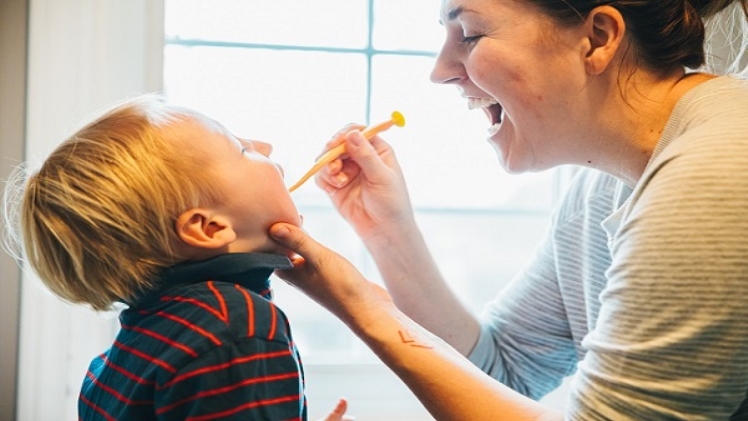A Guide to Keeping Your Child’s Teeth Healthy and Strong
Oral hygiene is an essential part of overall health, and teaching your children good oral care habits from a young age is crucial. But with so many oral care products on the market, it can be overwhelming to figure out which ones are right for your child at each stage of their development. In this article, we’ll break down the different types of oral care products and provide guidance on when and how to use them for optimal dental health.
Infants (0-2 years old)
While infants may not have teeth yet, it’s still important to keep their mouths clean and healthy. Start by gently wiping their gums with a damp washcloth or gauze after feedings to remove any milk or formula residue. As soon as their first tooth appears, typically around six months of age, it’s time to start brushing with natural toothpaste.
Toothbrush: Look for a soft-bristled, small-headed toothbrush designed for infants. The toothbrush should be able to fit comfortably in your child’s mouth and have a non-slip grip for easy handling. Choose a toothbrush with a small amount of toothpaste that is safe for infants, like a smear of fluoride toothpaste the size of a grain of rice.
Toothpaste: Fluoride toothpaste is recommended for infants once their first tooth emerges, but use a very small amount. The American Dental Association (ADA) suggests using a smear of fluoride toothpaste that’s about the size of a grain of rice. Make sure your child doesn’t swallow the toothpaste.
Toddlers (2-4 years old)
Toddlers are still learning how to brush their teeth effectively and will likely need help and supervision. By age three, most children have a full set of baby teeth, and it’s important to start instilling good oral care habits that will carry over into adulthood.
Toothbrush: Look for a soft-bristled toothbrush with a larger head and easy-grip handle. The toothbrush should be able to clean all surfaces of your child’s teeth and gums.
Toothpaste: Use a pea-sized amount of fluoride toothpaste for toddlers, and make sure they don’t swallow it. Encourage your child to spit out the toothpaste and rinse their mouth with water after brushing.
Children (5-7 years old)
By age five, most children have lost some of their baby teeth and have started to develop permanent teeth. This is a critical time for establishing good oral care habits that will last a lifetime.
Toothbrush: Look for a soft-bristled toothbrush with a larger head and easy-grip handle. Consider a toothbrush with a fun design or character to make brushing more enjoyable for your child.
Toothpaste: Continue using a pea-sized amount of fluoride toothpaste for children, and make sure they spit it out and rinse their mouth with water after brushing.
Mouthwash: Mouthwash can be used at this age, but make sure it’s alcohol-free and designed for children. Mouthwash can help freshen breath and kill bacteria that cause cavities and gum disease.
Preteens (8-12 years old)
As your child’s permanent teeth continue to come in, it’s important to emphasize the importance of good oral care habits. Preteens may be more independent with their oral care routine, but they still need guidance and supervision.
Toothbrush: Look for a soft-bristled toothbrush with a larger head and easy-grip handle. Consider a toothbrush with an angled head to clean hard-to-reach areas.
Mouthwash: Mouthwash can still be used at this age, but make sure it’s alcohol-free and designed for children. Mouthwash can help freshen breath and kill bacteria that cause cavities and gum disease.
Floss: Flossing should be introduced at this age to help remove plaque and food particles from between teeth. Use a flossing tool or soft dental floss to gently clean between teeth.
Teens (13-18 years old)
Teens have a greater risk of cavities and gum disease due to hormonal changes and increased sugar consumption. It’s important to encourage good oral care habits and regular dental check-ups.
Toothbrush: Teens can use a standard soft-bristled toothbrush with a larger head and easy-grip handle. Consider an electric toothbrush with a timer to ensure they brush for the recommended two minutes.
Toothpaste: Continue using a fluoride toothpaste and make sure your teen spits it out and rinses their mouth with water after brushing.
Mouthwash: Mouthwash can still be used at this age, but make sure it’s alcohol-free and designed for adults. Mouthwash can help freshen breath and kill bacteria that cause cavities and gum disease.
Floss: Flossing should be part of your teen’s daily oral care routine to help remove plaque and food particles from between teeth.
Orthodontics
If your child needs braces or other orthodontic treatment, it’s important to take extra care of their teeth and gums. Braces can trap food particles and make brushing and flossing more challenging.
Toothbrush: Look for a soft-bristled toothbrush with a smaller head that can fit around brackets and wires. Consider an electric toothbrush with a special orthodontic head.
Toothpaste: Use a fluoride toothpaste and make sure your child spits it out and rinses their mouth with water after brushing.
Floss: Flossing should be a daily part of your child’s oral care routine, but it may be more challenging with braces. Consider using a floss threader or special orthodontic floss to clean between teeth and around brackets and wires.
Mouthwash: Mouthwash can be used in addition to brushing and flossing, but make sure it’s alcohol-free and designed for adults.
Conclusion
Choosing the right oral care products for your child at each stage of their development is essential for establishing good oral care habits that will last a lifetime. Always consult with your child’s dentist to ensure you’re using the right products and techniques. By instilling good oral care habits at a young age, you can help your child maintain healthy teeth and gums for years to come.

